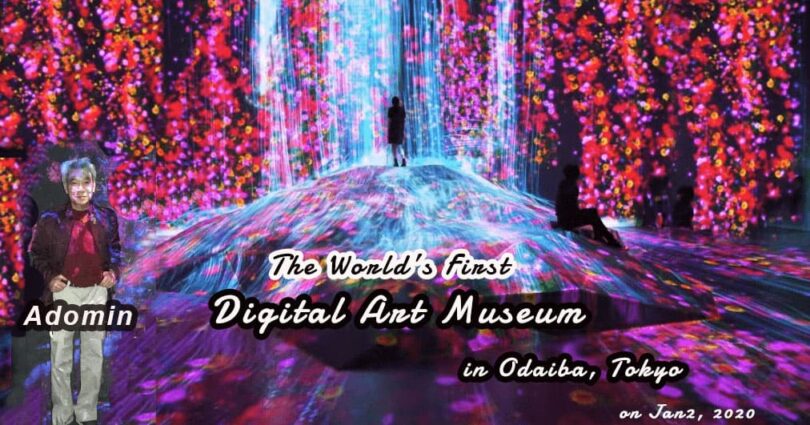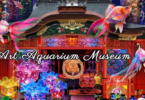Happy New Year 2020! How are you doing? I’d like to report on Digital Art Museum which is now exhibiting at the Mori Building Digital Art Museum
On January 2, 2020, New year’s holiday, I visited there and I was awfully surprised how crowded visitors mostly non-native Japanese from all over the world. In order to enter the site, we have to wait for nearly one hour outside making a long line as shown a photo below.
What happens when you combine 520 computers, 470 projectors, and up to 100 self-described ‘ultra-technologists’? teamLab decided to find out.
Contents
What’s “Digital Art Museum”?
Since 2001, the Japanese artist collective which comprises artists, architects, mathematicians and more has been pushing the boundaries of art with their immersive, often ephemeral, digital works.
The group has held wildly popular exhibitions across the world, and their eye-catching installations are shared widely on social media.
Japanese art collective teamLab has opened a bricks and mortar museum packed with 50 of its technicolour digital artworks in Tokyo’s Odaiba.
The colossal, 10,000 sqm space is the first digital art museum in the world, and is officially known as the Mori Building Digital Art Museum. Artworks are spread across the museum’s five zones and are designed to dissolve the boundary between visitor and artwork through interaction.
The museum features 50 of teamLab’s large-scale works, which are organised into five sections: Borderless World; Athletics Forest; Future Park; Forest of Lamps; and the En Tea House.
Every exhibit is interactive, responding to visitors’ movements to create an ever-changing display of light and colour.
Says teamLab: ‘Artworks move out of the rooms freely, form connections and relationships with people, communicate with other works, influence and sometimes intermingle with each other.’

“Universe of water particles on a rock where people gather’
Some 520 computers and 470 projectors power the digital artworks, which completely transform their physical space using animated graphics, colour and light.
Kaleidoscopic artworks are also programmed to ‘evolve’ through visitor interaction. Forest of Lamps sees a tree light up every time a person enters the room, while in the museum’s En Tea House, cups and plates burst to life with digital blooms.
Wander, explore, discover in one borderless world
teamLab Borderless is a world of artworks without boundaries, a museum without a map created by art collective teamLab.

The influence of Yayoi Kusama’s Infinity Mirrors is clearly evident in one of the Mori Building Digital Art Museum teamLab Borderless’ exhibition.
‘We want visitors to understand how digital technology can expand the conception of art. The art we create is made up of both the art and the viewer, and the existence and behaviour of the viewer can influence the art.’
Is it art? Intended as a social media spectacle? A technology showcase? An interactive museum? The Mori Building Digital Art Museum: teamLab Borderless seems all these things at once, and for better and worse, likely a precursor to a wave of exhibitions catering to the public’s demand for experiences worthy of a “like”.
By creating an environment in which human engagement drives the works, the collective hope to make the act of sharing the space with another visitor something powerful and integral to the experience of the artworks.
‘The paradigm in traditional art has been to treat the existence of other viewers as a nuisance, but if the effect of another person’s presence on the art is beautiful, it is possible that that person’s presence itself will be seen as beautiful,’ they add.
TeamLab have created Borderless with 21st century art-lovers in mind, designing each exhibit to be shared on Instagram. Exhibitions featuring highly ‘Instagrammable’ artworks such as Yayoi Kusama’s ‘infinity mirror rooms’ have drawn huge crowds across the world, showing the growing global appetite for this kind of participatory and photogenic art.
For teamLab, the focus on ‘shareability’ is underpinned by a firm belief in the uniting power of the web. It’s a theme that is addressed in Crystal Universe, 2015, a kaleidoscopic maze of hanging LED lights that change as visitors wander around, creating what the artists describe as ‘a sculptural body’.
Key to the work is a dedicated smartphone app that allows users to shape the environment they are standing in.
‘When you control the app, the artwork reacts, helping visitors create a scene that will never be repeated again,’ say teamLab. ‘The internet connection is what makes this artwork possible.’
By making the visitor an integral part of the world’s first digital art museum, teamLab are showing how technology and art can work together to bring people closer.
‘We hope that this exhibit will encourage people to rethink the relationship between humans and nature as well as their relationship with the world,’ they say.
Beyond that, Borderless also provides an alternative view of how we can relate to, and interact with, cultural spaces in the future, and explores the role that technology and the web will play in that transformation.
Tips and reminders for visiting teamLab Borderless
1. teamLab recommends visiting after 15:00 to avoid the crowd. However, wait times can vary from day to day; we got in line before opening—on a weekend, at that—and found the line to be quick-moving.
2. Children under junior high school age must be accompanied by an adult aged 20 or over.
3. Stow bulky belongings in lockers (¥100-yen refundable deposit required).
4. Download the teamLab app beforehand. Alternatively, the museum has free wifi, so you can scan a QR code at the entrance to download the app.
5. Heels, slippers, and open-toed sandals are not allowed in the Athletics Forest. Wear or bring appropriate footwear, or rent shoes (subject to availability) for an additional fee.
6. Some rooms have mirrors on the floor, so you might want to think twice about wearing short skirts or dresses. (You can borrow wrap-around skirts for free.)
7. Take lots of photos and videos, but immerse yourself in the experience as well.
8. Give yourself about two or three hours, at least, to enjoy the museum.
9. New: If you are happy to do a quick zoom around the museum just before it shuts on the weekend, you can get a slightly discounted Night Pass ticket for ¥2,900 from the official website, which allows entry after 6pm.







